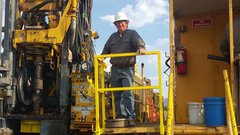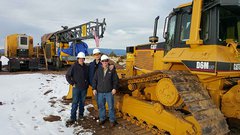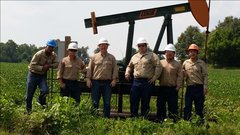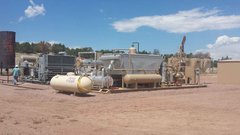AKK to Unlock 350 Wells in Coming Weeks?
Published 12-NOV-2015 10:31 A.M.
|
12 minute read
Hey! Looks like you have stumbled on the section of our website where we have archived articles from our old business model.
In 2019 the original founding team returned to run Next Investors, we changed our business model to only write about stocks we carefully research and are invested in for the long term.
The below articles were written under our previous business model. We have kept these articles online here for your reference.
Our new mission is to build a high performing ASX micro cap investment portfolio and share our research, analysis and investment strategy with our readers.
Click Here to View Latest Articles
Meet the ASX-listed oil company which is trying to keep costs down to such an extent that its CEO works the rigs in between important meetings.
This oil explorer has recently re-focused its energy on low cost, conventional, onshore oil potential – and could be about to unlock a truly significant oil play in the USA.
Estimates of production from a nearby producer is up to 75,000 barrels of oil per well, and this company thinks it may be able to drill 350 of them.
This is a demonstration of the scale this $8 million market cap company is looking at with its latest play.
In fact, at $50 a barrel this company could unlock ... we’ll let you do the maths on that one.
Drilling of this onshore conventional well is set to commence in the coming weeks.
But that isn’t the only play for this Company – in total, it has a stake in over 20,000 acres onshore USA, in some of the most prolific oil and gas producing basins in the world, including the Eagle Ford.
This company is producing right now and 57 wells are pumping out almost 4000 barrels of oil a month.
This small cap oiler has refocused as a lean, mean, oil producing machine and should the imminent December well come off it could become one of the great stories of the small cap oil space.
However, this is a blue sky estimate without any guarantees and caution should be exercised when considering this stock for your portfolio.
Now is the time to be looking at somewhat unloved oil stocks – it won’t take much for the price of oil to rebound, and from the current low base, nimble oil producers like this one can spring into top gear fairly quickly.
It’s time we took another look at:

Austin Exploration (ASX:AKK) is about to drill a conventional well in Colorado which could unlock big oil potential – 16 million barrels of oil are produced right next door to its project.
Drilling is set to start in December, just a few weeks from now, and a positive result could unlock the door to similar quantities of oil as its neighbour...
AKK has managed to take up this opportunity by focusing on low cost prospects, and by having the right connections.
Last month the company closed a rights issue, raising proceeds of over $600,000 – and the shortfall to raise up to approx. $2.6M is currently being placed.
We have covered AKK before at The Next Oil Rush , but had mainly focused on its unconventional prospects. Since this time the company has morphed into a low cost conventional onshore oil explorer that is also biding its time given the current price of oil.
This article will take you through all the latest happening with the Company.
Meet the suite
AKK has made the decision to play in the ultra-low cost environment that is the US oil and gas industry, where you can survive on oil prices of $40 instead of a high-cost jurisdiction such as Australia where the cost of drilling makes economics more difficult.
Traditionally, AKK focused on deep-lying shale plays in key areas such as the prolific Eagle Ford Shale and Niobrara regions.
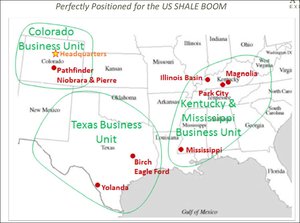
As you can see from the above map, AKK is focused on four key oil producing States in the US.
Its original focus was in Texas, where it played a key role in tapping sweet spots of the Eagle Ford shale, and managed to find a fair bit of oil.
In fact, according to a 2014 estimate it has net reserves of 11 million barrels, with gas reserves of 4.4 million mscf across all its assets:
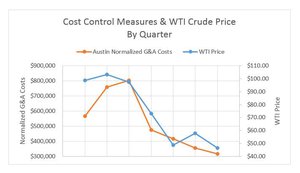
The Eagle Ford play is not a bad little money spinner, but AKK has farmed out to Halcon Resources and has tapped Meagher Energy Advisors to look for a buyer for its remaining 30% working in the Birch Eagle Ford Project.
It’s just too expensive to drill for a small company such as AKK, so while it does remain in Texas, it has narrowed its focus to Kentucky, Mississippi, and Colorado in response to the low oil price.
This play is being pursued by a lot of smaller oil and gas companies right now in light of the dwindling oil price.
Just the cost of leasing in Texas alone could be a drag on AKK’s balance sheet at current oil prices, and the costs associated with drilling in the shale don’t add up.
Without the cash to keep on drilling and without wanting to dilute shareholders, the play here is to realise some value for shareholders by attracting a bigger fish which can ride out the oil storm and pay to sit on the asset.
Meanwhile, Mississippi, Kentucky, and in particular Colorado offer up conventional oil potential which doesn’t cost a lot to drill.
In fact, by some estimates it costs less than $500,000 per producing well to drill. At $50 oil, this means a well simply needs to produce 10,000 barrels over its lifetime to pay back the cost of drilling.
As we’ll see later, AKK is looking to exceed these numbers by a fair way.
The eastern business unit (Kentucky and Mississippi)
Together, AKKs Kentucky and Mississippi projects make up its eastern business unit, where AKK is focusing on near term conventional oil production to help fund its higher stakes game in Colorado.
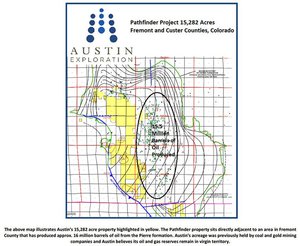
In the ‘ol’ Miss’, AKK has interest in several producing oil wells in Adams County, where it has targeted the oil-producing Wilcox Formation.
In fact, out of five wells it’s drilled in Mississippi, AKK has hit oil in all of them.
As those of you who have long (and sometimes bitter) experiences in oil investing, you know 100% is a pretty good strike rate to say the least.
It comes down to good project selection, and the management of the business unit led by Tim Hart who has been doing a great job in selecting the best opportunities for AKK.
It’s not easy selecting a low-cost entry which represents the best bang for shareholders’ bucks in a low-oil cost environment, but Hart and his team appear to have done just that.
Despite this, a 100% strike rate is unlikely to continue forever – oil explorers are speculative investments, and it’s always recommended to seek professional advice before investing.
AKK’s latest well at the Board of Education project hit 28ft (8.5m) of saturated oil sands .
The well is currently being flow tested, and AKK expects oil sales to begin from the project before the year is out.
AKK has a 37% net revenue interest in the 120 acre project and a 50% working interest.
Meanwhile, wells drilled in Kentucky continue to provide ongoing cash flow with daily production averaging 30 barrels of oil per day.
It may not seem like a lot, but for a company that (as we’ll demonstrate later) is keeping costs down, it’s handy cashflow.
While the cashflow from the 50% owned project will be nice for AKK, the real game could just be to the north in Colorado.
One well to unlock 350?
AKK’s Colorado project is what caused us to take another look at them.
Back in October it told the market that it had identified a high-impact oil target at its Pathfinder project, which overlies the prolific oil and gas-bearing DJ Basin.
Interestingly, the acreage had never before been drilled for oil and gas, making it rare ground in the DJ Basin which had not yet been drilled.
So how did AKK pick up the acreage in the first place from under the nose of the entire oil and gas community?
One of AKK’s non-executive directors is Dr Mark Hart, who is a man with a wealth of connections in North America.
He’s a man who’s been around the traps, and one of his previous roles was as managing director of Newmont Mining’s Canadian operations.
Newmont Mining was the original mineral rights holder for the Pathfinder project, but did not intend to drill for oil and gas. In short, Dr Hart was able to convince his ex-colleagues to sell the oil and gas rights to AKK.
Fast forward to July, and AKK had its first clue of the enormous oil potential of the Pathfinder project.
AKK drilled what it called the “C18-4” commitment well in order to fulfil its acreage deal.
That well hit gas, which wasn’t huge news for AKK. Gas is nice, but for a junior like AKK, tying everything up to a pipeline and pumping it out isn’t the most high-value play.
However, it was the presence of xylene in the gas which tipped AKK off to the fact that there could be oil to come.
Xylene is a petrochemical which represents about 0.5-1% of crude oil, so its presence in the gas made AKK follow up.
It did so using 3D seismic, which delineated an oil target in the Pierre shale.
AKK quickly moved to stake out the ideal drilling spot in preparation for drilling in December.
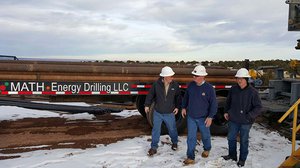
Should this well come off, it could just unlock a 350-well play on 100% owned acreage for AKK.
The drilling of the oil well will fulfil its acreage commitment for the entire 15,282 acre play.
It’s a project so big it can accommodate 350 conventional oil wells, and should the first one come off it may unlock the whole enchilada...
According to AKK’s reserves report, its Colorado asset has a p90 contingent resource of 15.4 million barrels of oil to a p10 resource of 26.6MMbbls, and that’s before the upcoming well has been drilled...
Comet Ridge drilling
AKK has a few things going in its favour here. The first is a bit of old-fashioned nearology.
Immediately to the east of the Pathfinder region is a project where 15.5 million barrels of oil have been produced so far.
ASX-listed Comet Ridge Energy (ASX:COI) has been at the forefront of this drilling, having drilled 25 wells at the project from 2008 to 2012.
Of the 25 wells drilled, 22 went on to become producers with the daily production from these wells reaching averaged 35,000 barrels of oil per well produced so far.
The estimated recoverable reserves from this field have been put at 75,000 barrels per well, a demonstration of the scale AKK could be looking at.
The 30 day average initial production figure from the Comet Ridge wells was 116 barrels of oil, with over 190,000 barrels of oil produced at the project from the Pierre shale (and still counting).
However, the best well had a 30-day initial production rate of 360 barrels of oil per day, meaning pay back of less than 45 days.
As you can see from the picture below, Comet Ridge’s former project is right next door to AKK’s (the parcels in yellow).
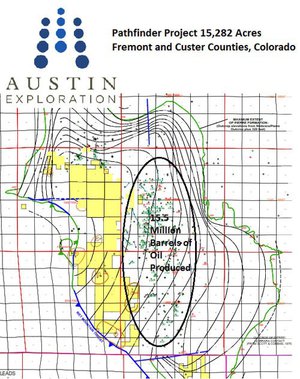
Now, nearology alone does not imply success in the same way correlation does not imply causation, so caution should be advised on trading on simple nearology.
Many bites at the play
One of the key characteristics of AKK is that it has re-tolled to become an ultra low-cost conventional oil driller, so longer-term things like cracking shale and new exploration horizons are somewhat grandiose notions to the company.
However, one look at the potential horizons it wants to hit demonstrates that should it be able to build a money-spinning monster from the Pierre Shale, then it could have a lot more upside to work on in the years ahead.
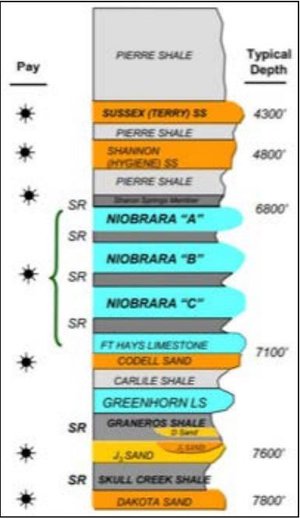
As you can see from the above, it has plenty of potentially juicy oil-bearing rocks to play with.
At the moment, it’s focusing on the shallow Pierre shale which won’t cost a lot of money to tap.
However, should it be able to do that and find itself awash in oil money, and oil prices start to improve, then AKK could start looking at three individual zones of the prolific Niobrara Shale.
The Colorado Oil and Gas Association has put the overall oil potential of the Niobrara Shale at 2 billion barrels of oil , but of course this estimate is somewhat malleable.
We will be keeping an eye on this asset (and the price of oil) over the coming months to see what kind of moves AKK make here.
A lean, mean, producing machine
AKK is in the middle of a play that many oil exploration companies in the US are going through at the moment – and it’s the smart play.
Instead of raising cash again, and again to hire all the equipment needed to chase big elephant shale targets, AKK has refined its focus on targets it can drill cheaply and for the maximum value for shareholders.
In fact, it’s managed to bring its normalised general and administrative cash costs down from above $800,000 in the third quarter of 2014 to less than $400,000 as it is at the moment.
As you can see from the chart below, this was done squarely with the focus on the WTI price.
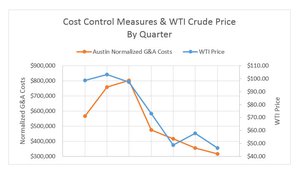
Source: Austin Exploration
Now, we know charts are one thing and they don’t really capture the situation on the ground, but we feel the below image does.
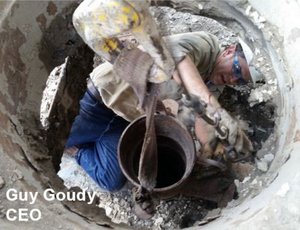
The man in the well is none other than AKK CEO Guy Goudy.
We’ve seen a lot of corporate presentations during our time at The Next Oil Rush and usually the closest CEOs get to the nitty gritty of it all is wearing a hard hat and a fluoro vest, standing around awkwardly while they’re posing for a photo.
But it looks like AKK is taking its cost-cutting measures very seriously.
In between swinging deals, Guy Goudy is swinging a hammer and literally helping create shareholder value.
We like it, and we’d like to see a few more junior resource company CEO’s pick up a hammer and help out.
However, more seriously, AKK recently did a deal with Math Energy Drilling to help keep drilling costs down and at the same time make sure its destiny is in its own hands.
AKK essentially tied up a 12-month drilling contract, so instead of having to go out to market each time it wanted to drill a well and try to source one, it’s now just got one for 12 months.
It helps that Dr Hart is on the board of Math Energy Drilling, and while the deal was done at arm’s length, AKK was able to secure the equipment “at a rate that is significant under market”.
“Lower oil prices call for cost-effective programs to be implemented for ongoing development to be economical,” Goudy told investors at the time.
“We now have a complete solution for the development of our Colorado property and for the first time the company is not constrained by external contractors.”
However, it’s not just a rig AKK is getting with the deal with Math Energy Drilling, it also includes a swathe of equipment which will allow AKK to construct its own drilling pads, build access roads, trench its own flow lines, and perform workovers of existing wells.
It’s just the latest way AKK has sought to lower its ongoing costs while still chasing drilling opportunities.
The Final Word
AKK has now completed its transformation into a low-cost driller.
It’s put its pie-in-the-sky shale dreams on hold (for now – just wait to the oil price turns back up again) and instead decided to focus on more realistic shallow oil prospects in an effort to create near term cashflow.
AKK is being realistic about the oil market, and decided to re-tool to meet it.
It’s the best part of a small company, being able to adapt quickly to changing market circumstances in order to actually create shareholder value at each step in the cycle instead of just hanging on for dear life and hoping things will improve.
It is still possible to make money from oil – and this is the way to do it.
By pursuing the new strategy, AKK is about to embark on a journey in a field which has never been drilled before and possibly turn one well into 350.
General Information Only
S3 Consortium Pty Ltd (S3, ‘we’, ‘us’, ‘our’) (CAR No. 433913) is a corporate authorised representative of LeMessurier Securities Pty Ltd (AFSL No. 296877). The information contained in this article is general information and is for informational purposes only. Any advice is general advice only. Any advice contained in this article does not constitute personal advice and S3 has not taken into consideration your personal objectives, financial situation or needs. Please seek your own independent professional advice before making any financial investment decision. Those persons acting upon information contained in this article do so entirely at their own risk.
Conflicts of Interest Notice
S3 and its associated entities may hold investments in companies featured in its articles, including through being paid in the securities of the companies we provide commentary on. We disclose the securities held in relation to a particular company that we provide commentary on. Refer to our Disclosure Policy for information on our self-imposed trading blackouts, hold conditions and de-risking (sell conditions) which seek to mitigate against any potential conflicts of interest.
Publication Notice and Disclaimer
The information contained in this article is current as at the publication date. At the time of publishing, the information contained in this article is based on sources which are available in the public domain that we consider to be reliable, and our own analysis of those sources. The views of the author may not reflect the views of the AFSL holder. Any decision by you to purchase securities in the companies featured in this article should be done so after you have sought your own independent professional advice regarding this information and made your own inquiries as to the validity of any information in this article.
Any forward-looking statements contained in this article are not guarantees or predictions of future performance, and involve known and unknown risks, uncertainties and other factors, many of which are beyond our control, and which may cause actual results or performance of companies featured to differ materially from those expressed in the statements contained in this article. S3 cannot and does not give any assurance that the results or performance expressed or implied by any forward-looking statements contained in this article will actually occur and readers are cautioned not to put undue reliance on forward-looking statements.
This article may include references to our past investing performance. Past performance is not a reliable indicator of our future investing performance.


